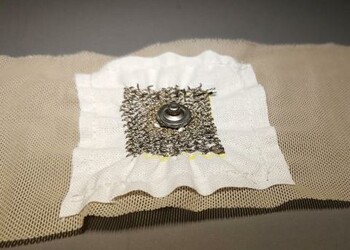Big Breakthrough to Give Us the Connected Garments We’ve Been Asking for
CAMBRIDGE, MA—Stretchable, bendable “smart” textiles are poised to reshape clothes of all kinds, creating new opportunities for integrating advanced monitoring technologies into everyday items. Retailers are already testing the waters, starting with fitness and outdoor gear. A report from tech analyst Gartner shows sales of smart garments skyrocketing from barely measurable in 2014 to 19 million shipments in 2022.
Advancing the technology is a team at Draper and the University of Colorado Boulder that is applying neuroscience and psychophysiology to build responsive technologies like those integrated in smart textiles. Recently the team uncovered a capability gap. They found that wearable sensor systems don’t seem to perform as well in monitoring heart rates as traditional electrodes. So they set out to find a better approach.
Katya Arquilla, who designs sensor systems for human spaceflight as a Draper Fellow, tested the feasibility of electrocardiogram (ECG) monitoring with sewn textile electrodes instead of traditional gel electrodes in a 3-lead, chest-mounted configuration. “The critical question is whether a sewn textile electrode can perform ECG monitoring to the same fidelity for the desired metrics as a traditional electrode. Commercially available wearables are usually incapable of detecting the full ECG waveform, and we wanted to close that gap.”
The team looked into a few options but were unsatisfied with current approaches. Conductive ink-based electrodes, which can be printed onto the fabric surface, tend to crack, causing breaks in the conductive surface and changes in resistance during movement. They also explored planar-fashionable circuit boards (P-FCBs), which similarly print onto the fabric surface, but require advanced manufacturing methods to produce the conductive paste.
The solution the team devised involved fabricating “dry” electrodes that are directly integrated in clothing. Andrea Webb, a scientist in human-centered solutions at Draper, explains: “Because our device conforms to the skin, it avoids noise and artifact issues that normally occur due to the motion of similar dry electrodes across the skin. The device ultimately should be able to provide accurate signals from a person who is walking, running or climbing stairs.”
Performance was undiminished after the device underwent a battery of validation tests, including ECG monitoring, comfort surveys with human subjects, stretch testing and wash cycling. Device performance matched the traditional electrode in being able to detect the full ECG waveform, too, a key finding for the team.
The authors describe the new sensor system in a research paper submitted to Sensors. Co-authors include Arquilla, who is a Ph.D. candidate at the University of Colorado Boulder; Allison Anderson, Arquilla’s academic advisor and Assistant Professor of Aerospace Engineering Sciences in CU Boulder’s Bioastronautics Lab; and Webb, Principal Scientist in Human-Centered Solutions at Draper.
Released December 16, 2019

